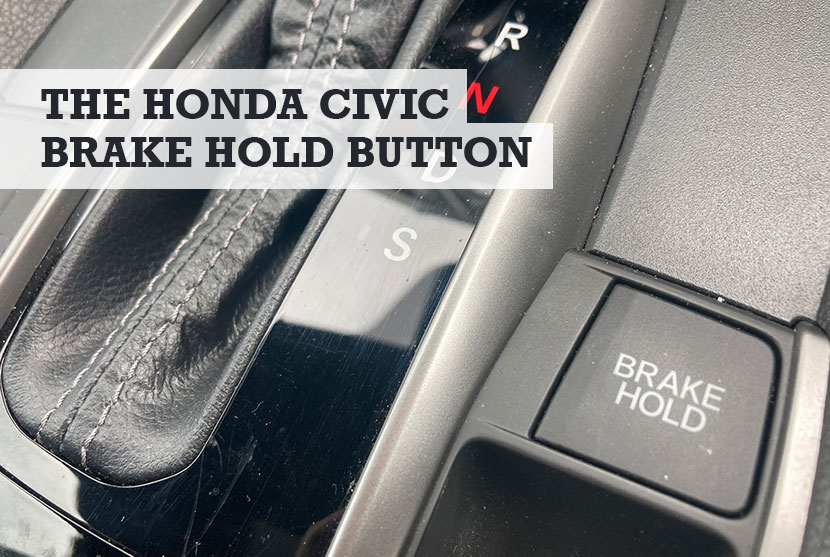If you own a tenth-generation Honda Civic, you will have noticed the brake hold button. Honda Civic brake hold is a unique feature of this manufacturer but is also one of the most confusing options to those unfamiliar with it. In this guide, I will explain what the brake hold button on a Honda Civic is and how to use it safely.
What does brake hold mean on Honda Civic? The Honda Civic brake hold button is a convenience feature best used in stop start traffic meaning you don’t have to keep your foot on the brake pedal. The system holds the brakes for you, so you don’t have to hold your foot down.
Honda Civic brake hold is best used at red lights, by stop signs, traffic congestion and drive throughs.
I appreciate that might not still answer all your questions about what the purpose of brake hold is, when to use it, and whether it’s ok to drive with brake hold on. All you need to know is below.

Honda Civic brake hold: what it does and how it works
The Honda Civic brake hold is not the same as your parking brake. Here’s how to use Honda Civic brake hold (in stop and start traffic is the best time).
For example, let’s say you are in a long traffic queue where you need to keep the Civic in drive, but keep stopping for periods of time. It can be annoying to have to keep your foot on the brake pedal each time you stop – the Honda Civic brake hold button takes that problem away – here’s how.
When you get into the traffic, press the brake hold button. You can continue to drive in D, then come to a stop by pressing on the foot brake. Even though you are still in gear and stopped, you can now take your foot off the brake.
Because the Honda Civic brake hold button is activated (a light appears on the dash), you can safely remove your foot from the brake pedal. The Civic will keep the brake on hold even though you are in drive.
If you are worried, there is a fail-safe mode. Let’s say you take your seat belt off, the parking brake will come on.
When the traffic moves again, press the gas, and off you go again, despite the brake hold light being on. Here’s a video explainer.
What is the purpose of brake hold?
The brake hold’s function is to stop a car while in Drive(D). For example, in a Honda Civic, the brake hold maintains the braking force with which a driver steps on the brake pedal.
Consequently, a driver doesn’t need to continually press the brakes, especially when waiting for a traffic light, moving through a drive-thru, or in a traffic jam. In addition, because you don’t have to press the brakes all the time, using a brake hold reduces foot fatigue.
When you activate the brake hold, a light will appear on the dashboard. You should see an indicator on your dashboard showing you if the brake hold is operating. After ten minutes of stopping the vehicle, the car automatically turns off the brake hold, and the indicator goes off.
How to turn off brake hold on a Honda Civic?
Using brake hold is one thing, but what about turning it off? Well, firstly you don’t need to worry about driving with it on. That’s what it’s meant for, and it will actually turn off automatically once you turn the ignition off.
However, if you want to turn off the brake hold on your Honda Civic when on a journey, simply follow these instructions when at a stop.
- Press your foot down on the brake pedal.
- Press the brake hold button again.
However, if you want to turn off brake hold when driving and in motion, it will do so under the following circumstances:
- Braking is applied for more than 10 minutes.
- The electric parking brake is engaged.
- The foot brake is pressed, and the gear lever is moved to P or R.
The brake hold light on a Honda Civic
The Honda Civic brake hold light is your best friend when using the function. When you first press it, one green light will appear on your dashboard. It’s now ready to use, and you can drive.

When you then come to a stop, and push onto the foot brake pedal, an additional green light will appear showing you that HOLD has been activated and will hold your Civic in place.
Honda brake hold problem and troubleshooting
As with any feature in your car, you might find that your Honda Civic brake hold is not working. This could be due to several reasons, the first being user error. Now you know how to use brake hold though, I hope that isn’t your specific problem… instead here are some possibilities.
- Possible bad battery problem (dead cell perhaps).
- Possible wiring problem.
Handy Hint: Another button that often confuses new owners is the ECON button. Here’s what it does and how best to use it.
FAQs on the Honda Civic brake hold button
Is it ok to drive with Honda brake hold always on?
You can drive with Honda brake hold on, after all, that’s what it’s designed to do – be used when you are in Drive. However, it will deactivate when you turn the ignition off, so you will need to turn it back on every time you start the car up again.
When not to use the brake hold system
Whilst it’s ok to drive with the brake hold on when in heavy traffic, there are times when you should not use it. On the official Honda website, they offer the following guidance.
“Using the automatic brake hold system on steep hills or slippery roads may still allow the vehicle to move if you remove your foot from the brake pedal. If a vehicle unexpectedly moves, it may cause a crash resulting in serious injury or death. Never use the automatic brake hold system or rely on it to keep a vehicle from moving when stopped on a steep hill or slippery roads.”
Do all Honda Civics have a brake hold?
Yes, all Honda Civics have brake hold, providing they are manufactured from 2015 onwards. Civics before that year will not have the brake hold button.

Honda has been making the Civic model since 1972. While the different generations of the car have featured various types of braking systems, it wasn’t until the tenth-generation models that they started featuring the electric braking system.
The tenth-generation models were first released in 2015 in North America, and they have been produced till the present.
All tenth-generation Honda Civics feature an electric braking system (EBS). The system comes with a brake hold and a parking brake.
The brake hold button is not a different feature from the electric parking brake; instead, it is an extension of the brake, increasing your safety and convenience. While the parking brake has a switch for activating it, you can activate the brake hold with a button.
What’s the point of using the brake hold button?
The brake hold reduces fatigue since you don’t have to step on the brake pedal before the car stops continuously. Also, the brake hold holds the brake, preventing your Civic from inching forward if it is still in gear or from moving backward when on an incline.
A recap on how to use the brake hold
You should be able to use brake now, but here’s a quick recap.
When you press the brake hold button, you should see the corresponding indicator light up on your dashboard. The next step is to press your brake pedal when your shift lever is in the Drive (D) or Neutral (N) mode. You will notice that your car comes to a complete stop and the “hold” indicator appears on your dashboard.
You can then take your foot off the brake pedal.
When you want to start moving, you can turn off the brake hold by pressing the brake pedal or pressing the “brake hold” button again. You can also press the accelerator pedal, release the clutch pedal, or shift into a gear to cancel the brake hold.
It is important to note that using the brake hold when your car is on a steep hill or slippery road does not stop your vehicle. Also, the automatic hold cancels when you unfasten your seat belt, turn your engine off, or apply the brake hold for more than 10 minutes.
Advantages of the Electric Braking System (EBS)
The EBS has several advantages over other brakes, including manual brakes. The brakes are more consistent and precise. If you must stop at high speeds, the brakes efficiently keep your car stable.
Furthermore, you don’t have to maintain electric brakes as much compared to other brakes. So, you only need a fix if something malfunctions or breaks, which rarely happens.
A significant advantage of the brake hold in EBS is that it keeps your car in place whenever you stop the car, and the feature is on.
Disadvantages of the Electric Braking System
The electric braking system has some disadvantages, including the size of the parking brake switch. The parking brake switch is relatively small, making it challenging to engage, especially in emergencies. In addition, a repair or replacement of the brake system parts comes at a high cost.
Handy Hint: Here’s the ground clearance for Honda Civic models from year to year.
Is brake hold the same as hill start assist?
Brake hold and hill start assist are similar but different. The hill start assist in the Honda Civic detects an incline and holds the brakes to prevent your car from moving backward. The feature holds the brake’s pressure momentarily, giving you enough time to move your foot from the brake pedal to the accelerator pedal.
Usually, the hill start assist goes on and off automatically, depending on the incline of where you are driving.
On the other hand, brake hold stops your car completely, preventing it from moving backward or forward and allowing you to take your feet away from the brake. In the case of brake hold, you must turn on the feature, and you can turn it off by pressing the accelerator or releasing the clutch.
Does brake hold save gas?
Your car burns fuel when it is running an automatic transmission in Drive mode. Usually, shifting your automatic transmission to neutral saves fuel. Consequently, because brake hold stops your car for a while, it saves you gas and keeps more in the tank.
Nevertheless, it is essential to note that the purpose of the brake hold in the Honda Civic is not to save gas but to reduce leg fatigue and improve safety.
Conclusion
The brake hold function on a Honda Civic can make driving easier, particularly when you often have to stop and go. You can activate the brake hold by pressing the brake hold button on the left of the shift lever.
After pressing the button, you should see the “brake hold” indicator on your instrument panel.
When you activate the brake hold on your Honda Civic, it automatically holds your brake for up to 10 minutes, allowing you to remove your foot from the brake pedal without your car moving forward or backward.






